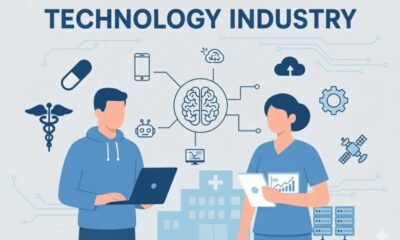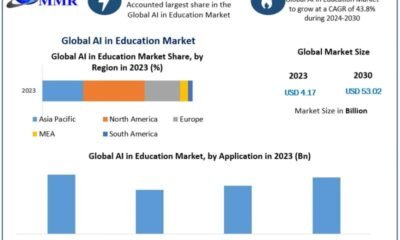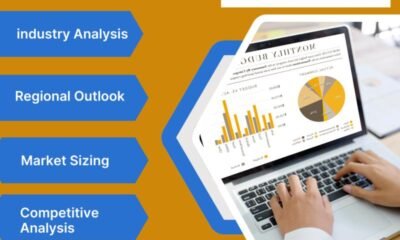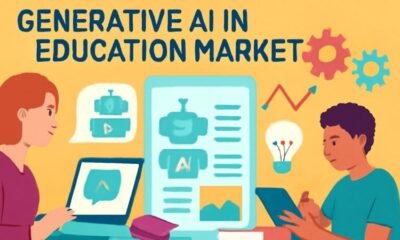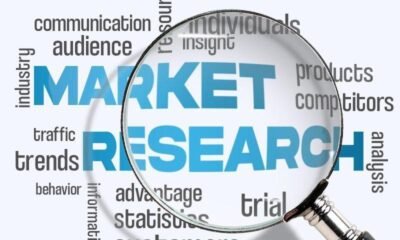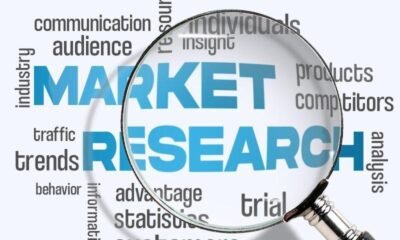AI Research
Artificial Intelligence in Healthcare Market : A Study of

Global Artificial Intelligence in Healthcare Market size was valued at USD 27.07 Bn in 2024 and is expected to reach USD 347.28 Bn by 2032, at a CAGR of 37.57%
Artificial Intelligence (AI) in healthcare is reshaping the industry by enabling faster diagnosis, personalized treatment, and enhanced operational efficiency. AI-driven tools such as predictive analytics, natural language processing, and medical imaging analysis are empowering physicians with deeper insights and decision support, reducing human error and improving patient outcomes. Moreover, AI is revolutionizing drug discovery, clinical trial optimization, and remote patient monitoring, making healthcare more proactive and accessible in both developed and emerging markets.
The adoption of AI in healthcare is also being accelerated by the rising demand for telemedicine, wearable health devices, and real-time data-driven solutions. From virtual health assistants to robotic surgery, AI is driving innovation across patient care and hospital management. However, challenges such as data privacy, ethical considerations, and regulatory frameworks remain crucial in ensuring responsible deployment. As AI continues to integrate with IoT, cloud, and big data platforms, it is set to create a connected healthcare ecosystem that prioritizes precision medicine and patient-centric solutions.
Get a sample of the report https://www.maximizemarketresearch.com/request-sample/21261/
Major companies profiled in the market report include
BP Target Neutral . JPMorgan Chase & Co. . Gold Standard Carbon Clear . South Pole Group . 3Degrees . Shell. EcoAct.
Research objectives:
The latest research report has been formulated using industry-verified data. It provides a detailed understanding of the leading manufacturers and suppliers engaged in this market, their pricing analysis, product offerings, gross revenue, sales network & distribution channels, profit margins, and financial standing. The report’s insightful data is intended to enlighten the readers interested in this business sector about the lucrative growth opportunities in the Artificial Intelligence in Healthcare market.
Get access to the full description of the report @ https://www.maximizemarketresearch.com/market-report/global-artificial-intelligence-ai-healthcare-market/21261/
It has segmented the global Artificial Intelligence in Healthcare market
by Offering
Hardware
Software
Services
by Technology
Machine Learning
Natural Language Processing
Context-Aware Computing
Computer Vision
Key Objectives of the Global Artificial Intelligence in Healthcare Market Report:
The report conducts a comparative assessment of the leading market players participating in the globalArtificial Intelligence in Healthcare
The report marks the notable developments that have recently taken place in the Artificial Intelligence in Healthcare industry
It details on the strategic initiatives undertaken by the market competitors for business expansion.
It closely examines the micro- and macro-economic growth indicators, as well as the essential elements of theArtificial Intelligence in Healthcaremarket value chain.
The repot further jots down the major growth prospects for the emerging market players in the leading regions of the market
Explore More Related Report @
Engineering, Procurement, and Construction Management (EPCM) Market https://www.maximizemarketresearch.com/market-report/engineering-procurement-and-construction-management-epcm-market/73131/
Global Turbomolecular Pumps Market
https://www.maximizemarketresearch.com/market-report/global-turbomolecular-pumps-market/20730/
Contact Maximize Market Research:
3rd Floor, Navale IT Park, Phase 2
Pune Bangalore Highway, Narhe,
Pune, Maharashtra 411041, India
sales@maximizemarketresearch.com
+91 96071 95908, +91 9607365656
About Maximize Market Research:
Maximize Market Research is a multifaceted market research and consulting company with professionals from several industries. Some of the industries we cover include medical devices, pharmaceutical manufacturers, science and engineering, electronic components, industrial equipment, technology and communication, cars and automobiles, chemical products and substances, general merchandise, beverages, personal care, and automated systems. To mention a few, we provide market-verified industry estimations, technical trend analysis, crucial market research, strategic advice, competition analysis, production and demand analysis, and client impact studies
This release was published on openPR.
AI Research
AI Research Healthcare: Transforming Drug Discovery –

Artificial intelligence (AI) is transforming the pharmaceutical industry. More and more, AI is being used in drug discovery to predict which drugs might work and speed up the whole development process.
But here’s something you probably didn’t see coming: some of the same AI tools that help find new drug candidates are now being used to catch insurance fraud. It’s an innovative cross-industry application that’s essential in protecting the integrity of healthcare systems.
AI’s Core Role in Drug Discovery
The field of drug discovery involves multiple stages, including initial compound screening and preclinical testing to clinical trials and regulatory framework compliance. These steps are time-consuming, expensive, and often risky. Traditional methods can take over a decade and cost billions, and success rates remain frustratingly low. This is where AI-powered drug discovery comes in.
The technology taps machine learning algorithms, deep learning, and advanced analytics so researchers can process vast amounts of molecular and clinical data. As such, pharmaceutical firms and biotech companies can reduce the cost and time required in traditional drug discovery processes.
AI trends in drug discovery cover a broad range of applications, too. For instance, specialized AI platforms for the life sciences are now used to enhance drug discovery workflows, streamline clinical trial analytics, and accelerate regulatory submissions by automating tasks like report reviews and literature screenings. This type of technology demonstrates how machine learning can automatically sift through hundreds of models to identify the optimal one that best fits the data, a process that is far more efficient than manual methods.
In the oncology segment, for example, it’s responsible for innovative precision medicine treatments that target specific genetic mutations in cancer patients. Similar approaches are used in studies for:
- Neurodegenerative diseases
- Cardiovascular diseases
- Chronic diseases
- Metabolic diseases
- Infectious disease segments
Rapid development is critical in such fields, and AI offers great help in making the process more efficient. These applications will likely extend to emerging diseases as AI continues to evolve. Experts even predict that the AI drug discovery market will grow from around USD$1.5 billion in 2023 to between USD$20.30 billion by 2030. Advanced technologies, increased availability of healthcare data, and substantial investments in healthcare technology are the main drivers for its growth.

From Molecules to Fraud Patterns
So, how do AI-assisted drug discovery tools end up playing a role in insurance fraud detection? It’s all about pattern recognition. The AI-based tools used in drug optimization can analyze chemical structures and molecular libraries to find hidden correlations. In the insurance industry, the same capability can scan through patient populations, treatment claims, and medical records to identify suspicious billing or treatment patterns.
The applications in drug discovery often require processing terabytes of data from research institutions, contract research organizations, and pharmaceutical sectors. In fraud detection, the inputs are different—claims data, treatment histories, and reimbursement requests. The analytical methods remain similar, however. Both use unsupervised learning to flag anomalies and predictive analytics to forecast outcomes, whether that’s a promising therapeutic drug or a suspicious claim.
Practical Applications In and Out of the Lab
Let’s break down how this dual application works in real-world scenarios:
- In the lab: AI helps identify small-molecule drugs, perform high-throughput screening, and refine clinical trial designs. Using generation models and computational power, scientists can simulate trial outcomes and optimize patient recruitment strategies, leading to better trial outcomes and fewer delays and ensure drug safety.
- In insurance fraud detection: Advanced analytics can detect billing inconsistencies, unusual prescription patterns, or claims that don’t align with approved therapeutic product development pathways. It protects insurance systems from losing funds that could otherwise support genuine patients and innovative therapies.
This shared analytical backbone creates an environment for innovation that benefits both the pharmaceutical sector and healthcare insurers.
Challenges and Future Outlook
The integration of AI in drug discovery and insurance fraud detection is promising, but it comes with challenges. Patient data privacy, for instance, is a major concern for both applications, whether it’s clinical trial information or insurance claims data. The regulatory framework around healthcare data is constantly changing, and companies need to stay compliant across both pharmaceutical and insurance sectors.
On the fraud detection side, AI systems need to balance catching real fraud without flagging legitimate claims. False positives can delay patient care and create administrative headaches. Also, fraudsters are getting more sophisticated, so detection algorithms need constant updates to stay ahead.
Despite these hurdles, the market growth for these integrated solutions is expected to outpace other applications due to their dual benefits. With rising healthcare costs and more complex fraud schemes, insurance companies are under increasing pressure to protect their systems while still covering legitimate treatments.
Looking ahead, AI-driven fraud detection is likely to become more sophisticated as it learns from drug discovery patterns. And as healthcare fraud becomes more complex and treatment options expand, we can expect these cross-industry AI solutions to play an even bigger role in protecting healthcare dollars.
Final Thoughts
The crossover between AI drug discovery tools and insurance fraud detection shows how pattern recognition technology can solve problems across different industries. What started as a way to find new medicines is now helping catch fraudulent claims and protect healthcare dollars.
For patients, this dual approach means both faster access to new treatments and better protection of the insurance systems that help pay for their care. For the industry, it’s about getting more value from AI investments; the same technology that helps develop drugs can also stop fraud from draining resources. It’s a smart example of how one innovation can strengthen healthcare from multiple angles.
Related
AI Research
LLMs will hallucinate forever – here is what that means for your AI strategy

The AI’s inescapable rulebook
Now let’s apply this to your AI. Its rulebook is the vast dataset it was trained on. It has ingested a significant portion of human knowledge, but that knowledge is itself a finite, inconsistent, and incomplete system. It contains contradictions, falsehoods, and, most importantly, gaps.
An AI, operating purely within its training data, is like a manager who refuses to think outside the company manual. When faced with a query that falls into one of Gödel’s gaps – a question where the answer is true but not provable from its data – the AI does not have the human capacity to say, “I do not know,” or to seek entirely new information. Its core programming is to respond. So, it does what the OpenAI paper describes: it auto-completes, or hallucinates. It creates a plausible-sounding reality based on the patterns in its data.
The AI invents a financial figure because the pattern suggests a number should be there. It cites a non-existent regulatory case because the pattern of legal language is persuasive. It designs a product feature that is physically impossible because the training data contains both engineering truths and science fiction.
The AI’s hallucination is not simply a technical failure; it is a Gödelian inevitability. It is the system’s attempt to be complete, which forces it to become inconsistent, unless the system says, “I don’t know,” in which case the system would be consistent but incomplete. Interestingly. OpenAI’s latest model has a feature billed as an improvement – namely its “abstention rate” (the rate at which the model admits that it cannot provide an answer). This rate has gone from about 1% in previous models to over 50% in GPT-5.
AI Research
Artificial intelligence is at the forefront of educational discussions

Artificial intelligence is at the forefront of educational discussions as school leaders, teachers, and business professionals gathered at the Education Leadership Summit in Tulsa to explore AI’s impact on classrooms and its implications for students’ futures.
Source: Youtube
-

 Business2 weeks ago
Business2 weeks agoThe Guardian view on Trump and the Fed: independence is no substitute for accountability | Editorial
-
Tools & Platforms1 month ago
Building Trust in Military AI Starts with Opening the Black Box – War on the Rocks
-

 Ethics & Policy2 months ago
Ethics & Policy2 months agoSDAIA Supports Saudi Arabia’s Leadership in Shaping Global AI Ethics, Policy, and Research – وكالة الأنباء السعودية
-

 Events & Conferences4 months ago
Events & Conferences4 months agoJourney to 1000 models: Scaling Instagram’s recommendation system
-

 Jobs & Careers2 months ago
Jobs & Careers2 months agoMumbai-based Perplexity Alternative Has 60k+ Users Without Funding
-

 Podcasts & Talks2 months ago
Podcasts & Talks2 months agoHappy 4th of July! 🎆 Made with Veo 3 in Gemini
-

 Education2 months ago
Education2 months agoMacron says UK and France have duty to tackle illegal migration ‘with humanity, solidarity and firmness’ – UK politics live | Politics
-

 Education2 months ago
Education2 months agoVEX Robotics launches AI-powered classroom robotics system
-

 Funding & Business2 months ago
Funding & Business2 months agoKayak and Expedia race to build AI travel agents that turn social posts into itineraries
-

 Podcasts & Talks2 months ago
Podcasts & Talks2 months agoOpenAI 🤝 @teamganassi




